Newsletter January 2001
Newsletter of the Al Ain chapter of Emirates Natural History Group
January 2001
Contents:
- Enjoying four hours in the mangroves of Khor Kalba
- Making marmalade: some recipe ideas for members
- What makes the water and beach sparkle like the stars?
- Hilli Fort open to public, restoration of landmark complete
- Celebrating the [bio]diversity of the United Arab Emirates
- Committee vacancies; volunteers needed for April meet
- Field Trips
Enjoying four hours in the mangroves of Khor Kalba
by Aroun VaittinadinWhen I first heard of a canoeing trip in the Khor Kalba mangrove, I immediately recalled spectacular sceneries of the Amazon River, with anacondas, piranhas and caimans hiding beneath greenish water. But what I was about to experience was beyond that!
The time and location of the meeting with the Desert Rangers -the tour organizers- were arranged by Debbie. We met on a Friday morning at 8:30 am. Instructions were given by a professional team who also indicated what paths could be explored in the mangrove. The explanations were brief but sufficient. Life jackets were distributed to all. We were about thirty people from ENHG, most of us not knowing one another. And I shall regret that people don't use this kind of event to take the opportunity to at least make a step towards their neighbors instead of staying by themselves. A simple friendly "hello" would be enough to warm up the atmosphere a little bit.
So here we go, my friend Jeff and me. Paddling, we moved to the first path, entering the mangrove. The passage was quite wide at the entrance but then narrowed onwards. I did enjoy the canoeing itself; you have a lot of fun avoiding getting stuck in the bank, the roots and the branches. At one narrow passage, we forced our way through low branches as far as possible, lying at the bottom of the canoe, the branches scratching our heads and arms. Then, all covered with mud and dead leaves, we had a hard time getting back but it was a lot of fun. Unfortunately I have to confess that the mangrove doesn't seem to be very large and you have seen much of it after four hours.
Only two paths go inside the mangrove, each of which can be covered in three quarters of an hour. Two other paths go around the mangrove but then you are no more surrounded with trees and you lose the feeling of being in a mangrove. What about the fauna? We saw neither water snakes nor anacondas for sure. We noticed some birds but my knowledge of them is too small to try to name them. The most impressive sight was certainly, nicer than the scary piranhas, schools of small glinting fish. From time to time they would all jump out of the water and one of them even landed into the canoe as we were moving above the school. In the end, canoeing in the mangrove between Oman and the Emirates was a nice experience. Maybe DH180 is a bit expensive for the rent of half a canoe, since there were two people to a canoe (how much does the canoe itself cost?) but, well, the Khor Kalba mangrove fortunately presents no risks other than that of getting a cramp in the arm while canoeing.
(Editor’s note: Thanks to Debbie Handley for organizing the group’s visit to Khor Kalba. Canoe trips in the mangroves are managed by a private company. For information to arrange a visit, please contact a committee member or email the Editor at bocknobby@hotmail.com.)

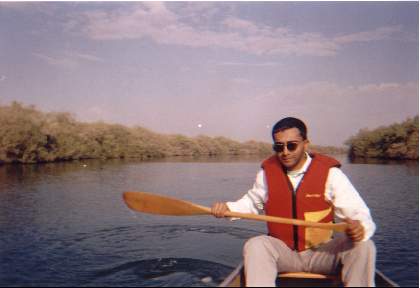
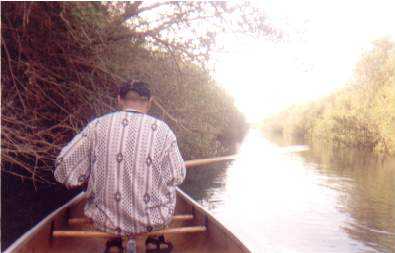
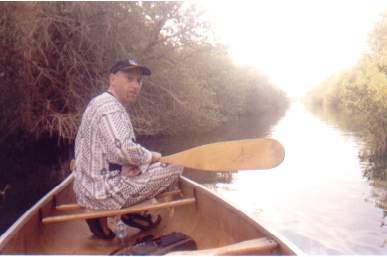
Return to top of page
Making marmalade: some recipe ideas for members
Tired of the fare available in the local markets to apply to your morning piece of toast or muffin? Why not make a batch of Al Ain marmalade?
Geoff Sanderson recently returned from a nearby oasis with a sample of the sour oranges which grow in considerable numbers. He reports that the result of his marmalade making session was, well, extraordinary!
If you would like a copy of Geoff’s recipe, contact him. Insha’allah we will have a copy of the recipe in the next issue of the Newsletter.
Anyone with other recipes to share?
Return to top of page
What makes the water and beach sparkle like the stars?
by Brigitte HowarthTwinkle, twinkle little star…how I wonder what you are…
Visiting the beach is always, I find, an exhilarating experience. The waves crashing around, stimulating the sensory, auditory, olfactory and visual senses; sea life nibbling at one’s toes; sea birds making familiar seaside sounds; soft sand cradling the soles of our feet before getting into just every possible nook and cranny, bag, sunscreen cream, and eventually driving us to the nearest freshwater shower to wash the unfamiliar, uncomfortable layer of extra skin off. However, the water and the beach attract us back again for another paddle or scour for that undiscovered seashell that might be waiting; an artefact washed up on the beach from a long lost civilization; a glimpse of wildlife not frequently seen; watching fishermen about their work; observing other beach dwellers enjoy their time; partaking in the activities that can be enjoyed in the wet matter…. Endless possibilities.
By late afternoon there is usually a break for some food as the light has faded but before retreating for the night some of us cannot resist the urge of tantalising the senses once more and venturing down to the beach to listen to the same sea in the dark, looking up at the sky and seeing a firmament full o glowing stars, identifying constellations, or possibly observing a particular phase of the moon.
Stars reflected on beach!The puzzling awakening is, though, when one looks down at the sea and the sand and finds the firmament reflected in it… ‘Pardon? Did I understand you right?’ You may ask. Yep, that is exactly what happened on a recent visit to the coastline near Fujarah. Not only were there ‘stars’ on the beach, they seemed to be in the water, too. I must admit that I was aware of these from a previous visit to that part of the coast but it always takes me by surprise.
This time I was armed… How? Simple. I had some tubes, a salad bowl, a spoon, and back at the Chalet I had my microscope waiting for me. Although previously identified, I wanted confirmation of my identification. So, armed with a sample of glowing sand and water I headed back to the microscope. To my utter surprise I found the sand totally alive with creatures, some I have not identified thus far.
The source of the light or ‘stars’ in the water and sand are very small (1-2 mm) water fleas, also known as plankton. These are found in many water environments and one common freshwater member of the group is called Daphnia. The water flea found on the beach was producing a fluorescent blue glow. Interestingly, when I picked some of them up on a spoon and then put them into a container full of water they would swim away, squirting the fluorescence out as they spun away, leaving a trail of colour. Also, some left little glowing trails on my finger. It is possible that the colour is produced and emitted under stress conditions. Alternatively, it might be a mating signal.
Host of life in a spoonfulOther creatures found included juvenile crustaceans, possibly a nematode, though again, it could have been a juvenile stage of some marine creature, other water fleas, and one peculiar type of worm. I’ve come to the conclusion it must be a flatworm, as it didn’t have all the characteristics of a leech. They did vaguely resemble sea slugs but they are so small (2-3 mm) and not colourful. My experience of flatworms is that they occur in freshwater rivers and lakes that are slightly polluted. There were at least three different species in the sea sample, varying in colour and colouration. I have brought some of these back with me and will endeavour to find out more and report what I find out when I am certain of the identification.
Armed with my microscope, a towel for protection thereof, and the same utensils as the night before, I set out the next morning to find more wonders in the sea and sand and to my utter surprise found hardly anything at all. Presumably there is a productivity period during the day and currents wash the animals and plants to shore. After high tide, and a wealth of nocturnal feeders have had their fill, the plankton may be occurring in lower numbers until more are produced. Just a thought, if anyone would be interested in sharing this experience during a weekend trip to the coast, get in touch, I’m certainly planning a return trip before the weather heats up.
(Editor’s note: Have you enjoyed a memorable trip somewhere in the UAE or Oman recently? Have you experienced something you never anticipated? Why not share that with other members of the group. Submit your articles and photos to the Editor at bocknobby@hotmal.com or contact any of the committee members listed on the back page of this Newsletter.)
Return to top of page
Hilli Fort open to public, restoration of landmark complete
by Phil IddisonI stopped at the Hilli Fort recently and found that it seems to be open for visitors. It is located to the east of the first roundabout north of the dolphin roundabout on the Dubai road. There is no information, just the name board and an open door which gives access up some steps to the elevated platform on which the main tower of the fort stands. There is a watchman who unlocked the door to the tower and gave me a guided tour with some basic information.
The fort has been restored and consists of an outer circular walled platform about 30 metres diameter on top of which is built a substantial two storey circular tower house wirh central access up to the roof level.
Mud and straw bricksMost of the construction is of mud brick reinforced with wheat straw. There are layers of stone reinforcement and exposed areas such as parapets and stairs have been cement rendered to prevent erosion.
There is not a great deal to explore but there are good views from the roof; over to the small square fort at Rumeilah, now stranded in the middle of modern development; over the adjacent plantation fields which are green with new crops at the moment (1/2001); over Hili oasis, giving a good impression of the extent of the date palm groves; to the two small falaj watch towers on the edge of the Hili oasis; and beyond the oasis there are distant views of Jebel Qatara, it was 3 PM so these were hazey, oppportunities for good phots at sunset!
The watchman lives in the outbuildings on the edge of the platform, a fragment of mirror is nailed to the external wall, no doubt for his morning shave. I was asked for tea money but told him that he was paid by the Heritage Department, it is up to visitors to reward him or not.
Behind the fort there is the oasis to explore, it is in the process of redevelopment like the Al Ain, Jimi and Qatara oases.
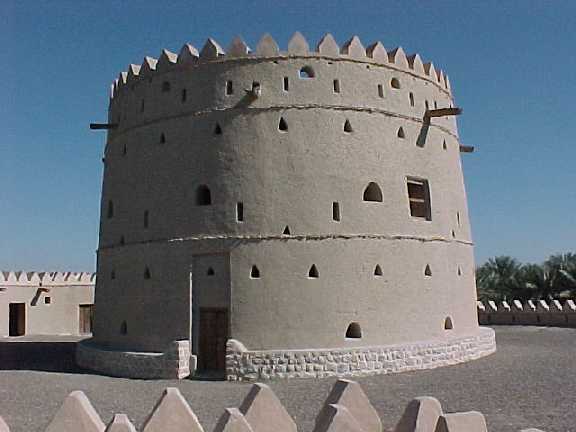
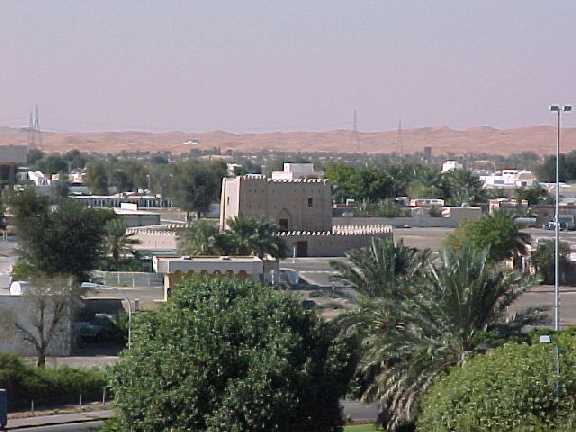
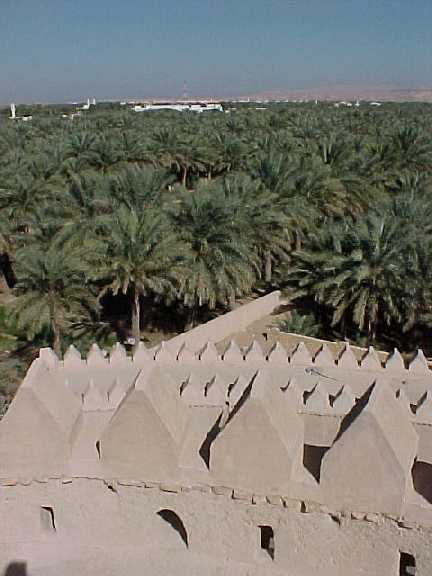
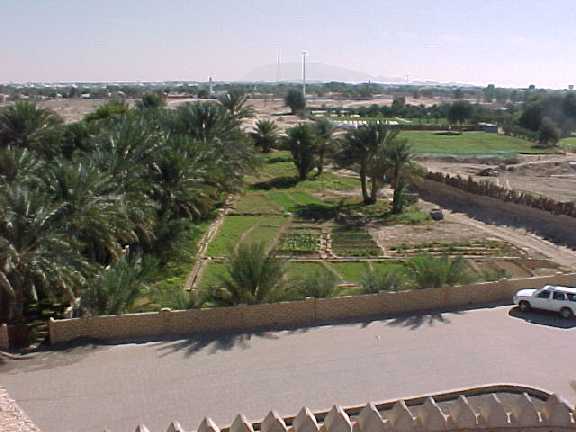
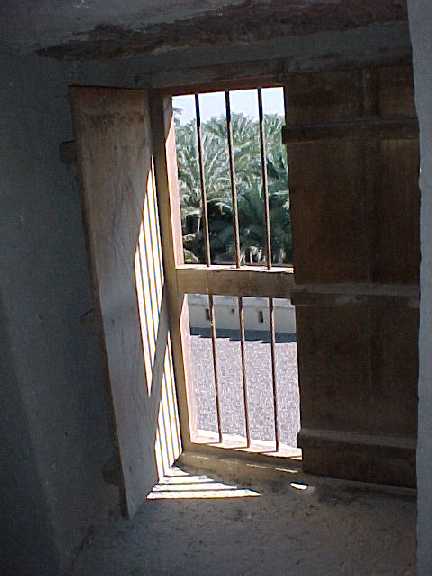


Return to top of page
Celebrating the [bio]diversity of the United Arab Emirates
(The following article appeared in the January 2001 issue of focus, the
newsletter of the Abu Dhabi chapter of the Emirates Natural History Group.)
by Steve James
Chairman, Abu Dhabi chapter of the ENHG
Biodiversity refers to the number, variety and variability of living organisms. Many scientists believe that the world is facing a mass extinction of diversity, largely because of human activities. A major contributor to depletion and extinction, second only to habitat loss, is the introduction of species into new environments. They are often called exotic species. Human exploration and colonisation has dramatically increased the spread of exotic species. Whenever and where-ever humans have settled far from home, they have tried to introduce familiar animals and plants, often with catastrophic results.
Some of our most abundant wild animals and plants, especially those that do well in urban or disturbed areas, are introduced species that have become established. The European Starling introduced in North America, Eucalyptus tree around the world and most insect and plant pests are exotic species. It is estimated that over 2,300 exotic animal species and over 4,000 exotic plants are now established in the United States! And the situation is still on-going, numbers are increasing every year.
Many exotics have disastrous effects on native flora and fauna. They often leave behind the factors that have evolved with them and that control their population and in new lands they spread. Very quickly these newly established populations can grow out of control. Exotics are a factor contributing to the endangered or threatened status of 42% of animals and plants on the U.S. endangered species list.
The spread of exotics replaces healthy, diverse ecosystems with biologically impoverished, homogeneous landscapes. A good example are places with a Mediterranean climate in southern Australia, west coast of U.S. and South Africa, previously had few plant species in common (although they did show many examples of convergent evolution, leading to similar landscapes). They now share hundreds of weedy exotic species, mainly from the Mediterranean region.
It seems that no area of the world is safe from introduced species. Hawaii, the world’s most isolated island group, over 3,500 kilometres from any major land mass has now over 2,500 alien arthropods. With increased travel, we sail and fly these unwanted guests, to even the remotest parts of the globe.
Here in Abu Dhabi the situation is much the same. The bright, colourful birds we take so much for granted, flying around the city are mostly alien species. The two species of parrot, the three species of bulbul and the vocal Grey Francolin are all non-native species. They have become a part of the Abu Dhabi landscape only because of human intervention. Exotic species are not confined to birds, both Rock Hyrax and more recently the European Red Squirrel have either been deliberately introduced or escaped from captivity and can be found in Abu Dhabi Emirate. But do these exotic species do any harm, here in the Emirates? Only time and research will provide the answer to this question.
But I believe that this is rather missing the point. What these alien species are doing, is detracting from the uniqueness of this country. Social and cultural values are quite rightly, jealously guarded in this part of the world. Surely, we should use the same values to conserve the biological diversity that makes Arabia unique? Do we really want the UAE to look like other parts of the world? To both visitors and ex-patriots alike what draws us to the country, is its rich heritage, culture and social customs, which set this place apart from the rest of the world.
For me, the diversity of nature was a natural draw. Species that I couldn’t see in my home country pulled me like a magnet to the UAE. The reason I like this country so much is because it’s not like other parts of the world; its uniqueness is a national treasure, to be guarded at all costs.
Once the UAE starts to lose its distinctiveness then I think this will be a sad day for all.
(Editor’s Note: Other articles from the newsletters of the Dubai and Abu Dhabi chapters of the ENHG will soon be available at the Al Ain website. In addition, the Dubai group recently decided to establish an email system similar to that which we use here in Al Ain. Members of individual chapters are entitled to join activities organized by other chapters so the establishment of these email groups will make it easier for individual members to be aware of events organized by other chapters of the ENHG. However, the Newsletter of the Al Ain group will continue to be available as not all members use nor have access to the Internet.)
Return to top of page
Committee vacancies; volunteers needed for April meet
As is often noted, one of the negative aspects of life in an expat community is the departure of friends with whom we have shared so many unforgettable experiences.
The Al Ain chapter of the Emirates Natural History Group recently suffered the loss of two of our most enthusiastic, generous and steadfast committeemembers, Irmgard Dommel and Renee Hefti-Graham. Many of our members will know Irmgard for her work as a volunteer on the membership desk each meeting where she assisted Diane to keep track of members. Renee was best known for her enthusiastic support for amateur photography and, most recently, her contribution to organize the annual photography competition.
If you are interested in serving on the Committee, please contact any committee member (see page 8). The Committee meets on the first Tuesday of each month at the Intercontinental Hotel to coordinate the activities of the chapter.
Inter-Emirates WeekendThe group is still anxious to hear from anyone who is interested in assisting in the coordination of events for the Inter-Emirates Weekend which the Al Ain chapter will present in April.
The Weekend is the annual event when members of Natural History Groups in Al Ain, Dubai and Abu Dhabi get together.
The plan for this year’s event is a traditional evening of food, song, dance and customs. This will be followed on Friday with special tours of Al Ain, including tours organized to highlight our special interest groups.
If you have some time to contribute, please contact a committee member as soon as possible.
Return to top of page
Field Trips
Field trips are organized for members of the Al Ain chapter of the Emirates Natural History Group. If you are interested in joining one of the field trips, please sign up at one of the regular meetings. Please sign only if you plan to attend as numbers may be limited. Tour organizers donate their time, vehicles and expertise. Your cooperation is very much appreciated.
Friday, February 2
Tour the Al Ain Oasis (limited numbers)
(See sign-up sheet and email)
Tour the Al Ain Oasis with Phil Iddison and Geoff Sanderson, including a stop at farms and a section of afflaj constructed by H.E. the President Sh Zayed. The plan is for the group to be divided into two parties, touring with Phil to discuss some of the food items produced in the Oasis, others travelling with Geoff to review the history of the Oasis. The tour will include a stop for lunch (paid for by individual members) at the restaurant in the center of the Oasis.
Where to meet: (see sign-up sheet, watch for email)
What to bring: camera, drinking water, walking shoes.
Thursday/Friday, February 8/9
Overnight camping and wadi walk (family event)
In January, inclement weather forced us to reschedule Debbie Handley’s proposed overnight camping trip which includes a wadi walk in Wadi Agran. “The camp is not too far away in Wadi Agran,” Debbie reported. Return by 5 pm Friday. The walking trail will be flat and campers will enjoy a full moon! Contact Debbie (muffet@emirates.net.ae) for more information.
Where to meet: Meet at the Hilton parking lot by main front entance at 3:15 pm.For those not camping meet at the Hilton parking lot at 8:30 am on Friday to go on wadi walk.
What to bring: camping gear, water, lunch, good hiking shoes.
Friday, February 9
Arthropod Day (family event)
Join Brigitte Howarth and other arthropod enthusiasts for a specimen collecting trip. This event is open to all members. The group already has a significant collection of arthropods and will conduct this tour to see which species may be visiting the district during winter. Contat Brigitte via home phone 7614316 or e-mail bhowarth@emirates.net.ae
Where to meet: lower parking lot at the Intercontinental Hotel at 8 am for an 8:15 departure.
What to bring: camera, water, hiking/walking shoes, containers for specimens. (Nets will be provided.)
Thursday, February 15
Trip to Sharjah Natural History Museum and Desert Park (family event)
Ellen McFarland has investigated the Sharjah Museum and is prepared to lead members to one of the most popular attractions in the Emirates. The hours of operation on Fridays are very limited so this Thursday date is recommended. The Museum is well signed and well organized, so no tour guide is necessary. A guide for the Desert Park portion is being arranged. This is an excellent family activity.
Where to meet: (to be announced)
What to bring: camera, water, hiking/walking shoes.
Sunday, February 18
Pinning and identification of arthropod specimens (family event)
Indoor meeting suggested for Sunday 18th February at Brigitte’s house, starting at 7.30 pm. Contact Brigitte via home phone 7614316 or e-mail bhowarth@emirates.net.ae
Thursday, February 22
Early morning photography session
Brigitte would like to go on a sunrise photography session. “Thursday morning is best for me and I suggest the 22nd February, probably meeting at 5.30 for a drive to a suitable location. Interested? Please contact Brigitte via home phone 7614316 or e-mail bhowarth@emirates.net.ae
Proposed
A number of field trips are being organized for the new year including:
- a tour of a juice processing plant in Al Ain
- a visit to the Buraimi camel souq
- a cooking da
- a visit to Fossil Valley to search for fossils and evidence of two Stone Age sites
- a visit to the Hanging Gardens to compare the assortment of floral at the site compared to the varieties observed in the autumn
- a visit to a traditional medicine shop in Al Ain
- a visit to one or more of the archaeological sites being worked this season a number of activities by the Special Interest Groups
If you are interested in helping to organize any of the above events, please contact a member of the committee. Do you have a field trip you are looking forward to, a place you would like to visit, but would like someone to join you? Write to enhg@listbot.com.
Return to top of page